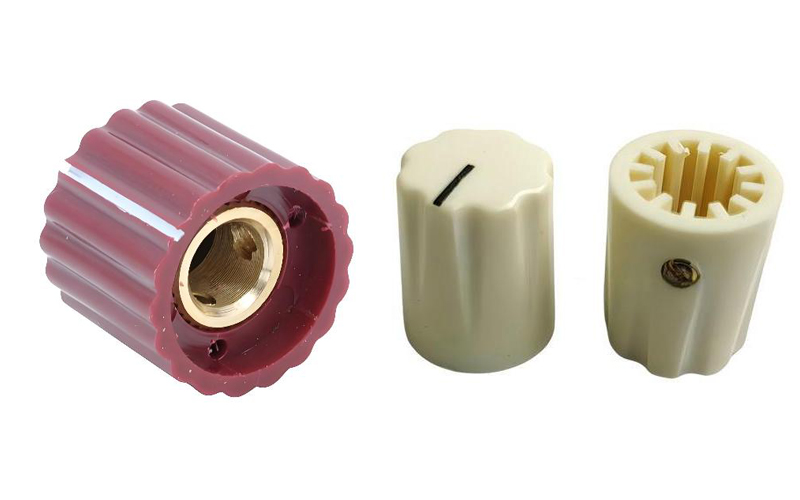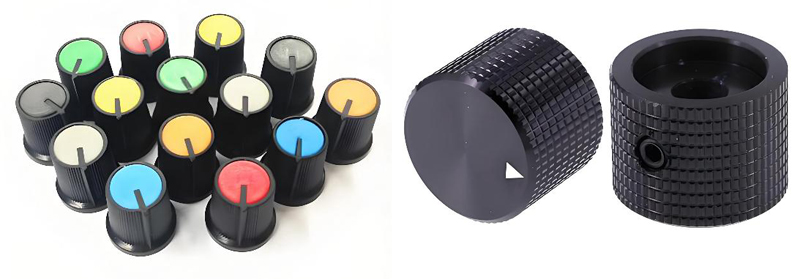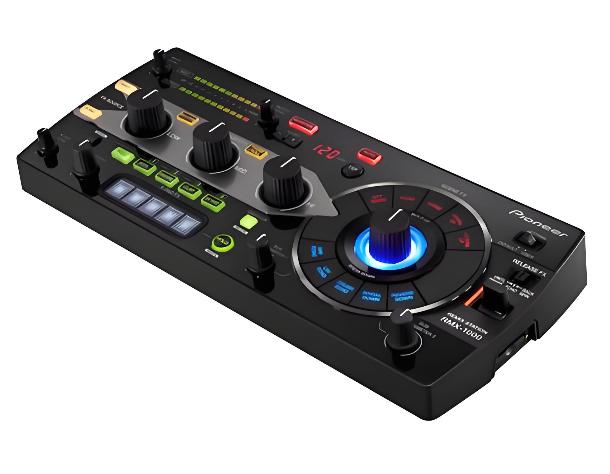
Knobs may be among the smallest components on a guitar or effects pedal, but they play a crucial role in your interaction with the equipment. Whether it’s tone, volume, gain, mixing, or EQ, every adjustment relies on these seemingly insignificant parts. They affect the feel of the equipment, the precision of the settings, and even the appearance of your gear on stage or in the studio.
If you’re exploring knobs for guitar effects pedals, stomp-boxes, or guitar control panels, this article will provide a comprehensive and in-depth look at knob styles, installation methods, materials, design considerations, and practical applications.
Why Knobs Matter More Than You Think?

A knob seems like a simple circle of plastic or metal, but it’s actually the interface between your fingers and the electronics that shape your tone. A smooth turn, a confident stop at each end of the range, the right amount of grip, these details affect how easily you can adjust settings mid-performance.
On pedals, knobs serve as quick visual cues. A bright or distinctive knob helps you identify a control instantly when you glance down at your board. On guitars, knobs can dramatically influence the personality of the instrument. A vintage-style bell knob on a single-cut guitar communicates something different from a dome-style metal knob on a modern design.
But beyond aesthetics, proper knob fitment is essential. A poorly fitting knob can wobble, slip, sit crooked, or in some cases fail to turn the potentiometer completely. Over time, mismatched knobs can even damage the pot shaft. Understanding the mechanical side ensures you get reliable performance along with style.
What are Pot Shafts and Fitment?

Before picking colors, shapes, or materials, you need to know what kind of shaft your potentiometer uses. Different guitars and pedals use different types, and matching your knob to the shaft prevents almost all installation issues.
Compatibility depends primarily on two factors: the diameter of the switch and the type of switch. Many imported instruments and effects pedals use 6mm (metric) switches, while others may use 6.35mm (¼ inch) switches. Even slight differences in diameter can affect how well the knobs will fit.
Splined shafts have ridges, either fine or coarse. A knob designed for fine splines won’t fit securely on a coarse spline, and vice versa. Smooth shafts require knobs with a set screw, which clamps onto the shaft’s flat side. Trying to press a splined knob onto a smooth shaft usually results in slipping or unstable movement.
Understanding these subtle differences ensures that when you press or tighten the knob, it seats perfectly, engages the pot cleanly, and gives you a solid, predictable feel. Once you confirm fitment, you can explore style with confidence.
Choosing the Right Style for Your Instrument or Pedal
Knobs come in a wide variety of shapes, each offering a different ergonomic experience. Some styles are classic, others modern, and many are tied to specific instrument traditions.
Bell or Hat-style knobs, often found on vintage-inspired guitars, provide a familiar taper and a comfortable grip. These are ideal if you frequently ride the volume knob during playing. Dome knobs, common on Telecasters and many basses, offer a clean, rounded profile with textured sides that feel secure under your fingers. Their simple geometry fits both vintage and modern aesthetics.
For pedal builders, barrel or speed knobs often work best. Their straight cylindrical sides allow fast, precise adjustments, especially helpful on gain and tone controls. Some have textured surfaces for added grip, while others use smooth finishes for a refined look. Low-profile knobs are useful on compact pedal layouts; they reduce the chance of accidentally bumping a control while stepping on a footswitch or maneuvering a patch cable.
No matter what you choose, think about how your hands naturally move while playing. A knob that looks beautiful but feels awkward can slow you down or make fine adjustments difficult.
How Materials Affect Feel and Durability?

Knobs can be made from plastic, resin, aluminum, steel, or hybrid materials. Each has benefits depending on your application.
Plastic knobs are lightweight and widely used. They’re ideal for large pedal builds, simple guitar layouts, or projects where you want a classic appearance without adding unnecessary weight. Vintage-style resin knobs give a retro aesthetic, great for rebuilds or instruments that emphasize old-school character.
Metal knobs, including aluminum and steel, offer a noticeably more substantial feel. The extra weight creates smooth, confident rotation. They’re highly durable, resistant to cracking, and give off a premium look. Pedals that see a lot of travel or gear that gets adjusted frequently benefits from the ruggedness of metal.
Some metal knobs feature knurled textures, giving you excellent grip even with sweaty hands or under low-light conditions. This is one reason many players prefer textured metal knobs on their main control surfaces.
Color, Indicators, and Visual Communication

A knob’s color and markings are more than decoration; they’re a communication tool. On a guitar, bright knobs can highlight controls, while understated ones blend into the design. On pedals, color-coding becomes a practical advantage.
For example, gain might use a bold color, tone a cooler shade, and volume something neutral. Even within a single pedal, different knob sets can help you differentiate primary controls from fine adjustments.
Indicator lines or dots are crucial for accuracy. They show you exactly where the control is set, even under dim stage lighting. Think about the visibility of these indicators against both the knob color and the pedal or guitar surface.
Some high-end knobs use glow-in-the-dark or UV-reactive indicators, making them ideal for live performers. Even without special effects, a simple contrasting stripe can make a big difference in usability.
Installing or Replacing Knobs
Here is a step-by-step guide for replacing knobs, applicable to guitars or effects pedals.
Step 1: Disconnect Power and Prepare
- For effects pedals: Disconnect the power and unplug the cables. If the casing is open, be sure to take electrostatic discharge (ESD) precautions.
- For guitars: If necessary, loosen the strings and ensure grounding (especially if the control chamber is open).
- Clear the space and prepare your tools (screwdriver, small wrench, rag, and possibly a pry tool for wiggling).
Step 2: Remove the Existing Knob
- For screw-mounted knobs: First loosen the small screw on the side.
- For push-in knobs: Gently pry upwards; avoid forcefully turning.
- Clean the knob shaft of dust or residue.
Step 3: Inspect the Shaft and Confirm Proper Installation
- Measure the diameter and, if necessary, count the number of spline teeth.
- Determine if the shaft is smooth or splined.
- Confirm whether the knob uses a set screw or push-in mounting.
Step 4: Install the New Knob
- Align the pointer markings (if any) with the correct position on the panel or PCB.
- Push the knob in directly (push-in type), or slide it in first and then tighten the side screw (set screw type).
- Ensure the knob is properly installed and does not tilt or wobble.
Step 5: Test Travel and Position
- Rotate the knob to its full travel to ensure smooth operation.
- For potentiometers, check for popping sounds or abnormal readings (if possible).
- For pedals: Power on and adjust the knob to confirm the response is as expected.
Step 6: Final Check
- Ensure the knob clearance is safe (it will not be touched by cables or PCB edges).
- For effects pedals, ensure the knob does not interfere with the footswitch or tailplate.
- For guitars, check that the strap or pick hand will not accidentally touch the knob while playing.
Practical Tips
When installing knobs on a guitar: Before installing a knob, rotate the potentiometer knob fully upwards (or downwards) to ensure proper alignment with the pointer markings.
If you have multiple knobs with different functions, consider using different shapes or colors to distinguish them by touch.
If a knob is frequently loose, apply a small amount of low-viscosity threadlocker or check the installation of the fixing screws.
Why Choose BITUO Knobs for Guitars and Effects Pedals?
Let’s explore in detail why BITUO’s “Guitar Effects Pedals Accessories/Knobs” category is ideal for your projects.
Extensive Accessory Selection
BITUO offers a wide variety of knobs for different applications (effects pedals, guitars, electronics). Whether you need sleek aluminum knobs, low-profile plastic knobs, or color indicators, their catalog has something for you.
Clear Engineering and Specifications
While product information in catalogs may not always be presented in plain language, BITUO accessories typically include information such as material, bore diameter, and mounting specifications. This is crucial for matching specifications.
For example: If you’re using a standard 6mm potentiometer on your effects pedal, you’ll need to choose a knob that matches its size.
Cost-Effectiveness for Bulk or Project Production
If you’re building multiple effects pedals (DIY boutique, mass production), sourcing consistent knob components (material, color, bore diameter) helps maintain a consistent feel and look across all your products. BITUO’s component categories are designed to meet your needs.
Customization Potential
In many cases, you can mix and match different materials, finishes, and colors. This allows you to customize knobs to match your brand’s aesthetic, match them to your effects pedal panel, or create custom limited editions. Knobs will become part of the “signature” feel of your work.
Suitable for Effects Systems
Effects systems have different knob requirements than guitars. You typically need to arrange many knobs closely together. You’ll need:
- Low-profile knobs (to avoid accidental impacts)
- Clear markings (for easy and quick adjustments)
- Durable materials (to withstand the wear and tear of shipping and touring)
- BITUO’s product catalog is ideal for such applications.
Avoiding Common Knob-Selection Mistakes
One of the most common mistakes players make is overlooking shaft compatibility. Assuming a knob will fit simply because it looks right can lead to wobble, slipping, or uneven seating. Measuring your pot shaft and confirming the knob’s specifications avoids this problem completely.
Another frequent issue is choosing knobs that are too tall or bulky for a particular layout. On tightly packed pedals, oversized knobs can interfere with switches, cables, or even your foot. On guitars, a knob that sits too high can get bumped accidentally during performance.
Aesthetic mismatch is also easy to overlook. A highly reflective metal knob may look great in photos but clash with a matte pedal enclosure or vintage guitar finish. A little planning goes a long way.
Finally, players sometimes underestimate the value of grip. Smooth knobs can be stylish, but if you often make quick adjustments, textured sides may serve you better.
Conclusion
A well-designed knob not only enhances the overall look of your equipment but also improves the playing experience. The right style, the right size, and the right materials to meet your needs can make your control knobs feel like an extension of your hands.




